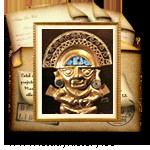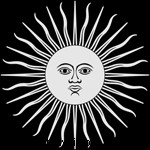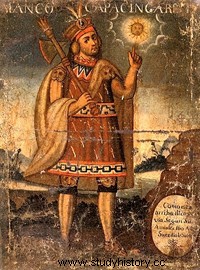 Many of you have probably heard more than once about the Inca Empire, which once existed in South America and which fell victim to the greed of the Spanish conquistadors . We will consider the history of the Inca civilization itself a little later, but for now we will get acquainted with the religion of the Inca empire. So, what did the ancient Incas believe in and what religious rituals did they perform.
Many of you have probably heard more than once about the Inca Empire, which once existed in South America and which fell victim to the greed of the Spanish conquistadors . We will consider the history of the Inca civilization itself a little later, but for now we will get acquainted with the religion of the Inca empire. So, what did the ancient Incas believe in and what religious rituals did they perform.
Inca Sun Cult
The deification of the Sun is a phenomenon common in many parts of the globe, but the Incas surpassed all tribes and peoples in this, calling themselves “sons of the Sun”. The image of the luminary in the form of a golden disk with a human face served as the subject of an official cult. Two of the most famous legends about the founding of the Inca empire are also associated with the name of the Sun.
Once upon a time, spouses (they are also brother and sister) Manco Capac and Mama Oclio came out of Lake Titicaca. From their father Sun, they received a magic golden rod. This wand was supposed to show them where they should found a city, which was later destined to become the capital of a great power. Their search was long and difficult. The rod did not react either to the mountains or to the valleys, but one fine day, near the Wanankaure hill, it suddenly went into the ground. This is how the capital of the Inca empire arose - the city of Cusco (which means "navel" or "heart"), and Manco Capac erected the palace of Kelkkampata, the ruins of which can still be seen today.
 Another legend tells how four pairs of men and women came out of a cave that had four windows. The men were the Ayar brothers. They all decided to follow the Sun. The difficulties of the unknown path did not frighten them, just like the battles with the warlike tribes they met along the way. However, after another battle, only Ayar Manco and his wife Mama Oklio survived; the rest either perished or turned to stone. This single couple reached Cusco and founded an empire there.
Another legend tells how four pairs of men and women came out of a cave that had four windows. The men were the Ayar brothers. They all decided to follow the Sun. The difficulties of the unknown path did not frighten them, just like the battles with the warlike tribes they met along the way. However, after another battle, only Ayar Manco and his wife Mama Oklio survived; the rest either perished or turned to stone. This single couple reached Cusco and founded an empire there.
Lake Titicaca is directly related to the birth of the Sun. The Aymara Indians, who lived from ancient times in the vicinity of this lake, believed that the creator god Viracocha (or Tonapa) appeared on earth from the temples of the lake and created the Sun and other heavenly bodies. Viracocha - the mysterious "white" god - tall, strong, dressed in all white. He is determined and all-powerful. When this god first appeared in the Andes, people met him very hostilely, and he even had to call fire from the sky and “light the mountain” (hence, apparently, the name Viracocha comes from - Lava Lake) in order to be recognized as a god. It is no coincidence that the Temple of Viracocha was located at the foot of an extinct volcano, in the Hulcamayo Valley.
On the territory of the vast Inca empire, the Sun was known by various names, the most common and popular of them was Inpgi. In some areas of the empire, Viracocha and Inti were perceived as the same deity.
Inca Pantheon
The fire god Pachacamac was also highly revered, reviving everything that was created and then died for one reason or another. Among the main Inca gods, Chaska (Venus), Chukuilya (goddess of lightning), Ilyana (god of thunder), Pachamama (goddess of fertility), Kilya (goddess of the Moon, sister and wife of the Sun, patroness of married women) and Kon (god of noise) stand out. Some gods were triliks. Thus, the god of thunder had three hypostases:“spear of light” - lightning, “beam of light” - thunder and the Milky Way.
There was also an image of the devil in Inca mythology - the personification of everything that was despised by the Incas. The devil (Supai) tried to oppose the gods in everything and sought to cause as much harm as possible to people. And of course, he interfered with the fulfillment of the main covenants by which the Incas lived:“ama sua” - “do not steal”, “ama lyulya” - “do not be lazy” and “ama cella” - “do not lie”. But what could even the most sophisticated devil do against such a great god as Inti-Sun!
The Incas deified animals, birds, plants, worshiped some reptiles and amphibians. The number of sacred animals included fox, bear, puma, condor, dove, falcon, snake, toads, etc.
The Supreme Inca (emperor) was recognized as a descendant of the Sun and a mediator between the divine and human worlds. He was considered immortal. And even if the Supreme Inca died, the Incas believed that he continues to influence people's lives. It is noteworthy that in addition to wives and children, the High Priest (Viljak Umu) was officially part of the imperial family. This emphasized the divine origin of the latter.
Inca priesthood
Like the priests of the famous Oracle of Delphi, the priests of the largest Inca temples played a huge role not only in the economic but also in the political life of the "empire". It was often they who determined the next "emperor."
The priesthood was numerous and divided into several categories. A special group was alkas - "virgins of the Sun", who lived in special temples - alkau-asis. They were recruited from the clan (kind) of the Supreme Inca from the age of nine. They became the keepers of the solar fire, and, in addition, their duties included sewing clothes for the Inca and his entourage, preparing food and drinks for the imperial family on holidays.
Inca concept of the universe
 According to Inca beliefs, the universe - pacha - was created by the Supreme Creator of all things from water, earth and fire. It consisted of three worlds:the upper world (khanan pacha), where the heavenly gods lived; the inner world (uku pacha), where people, animals and plants lived; and the lower world (huRin pacha) - the kingdom of the dead, living in the afterlife (underworld) and those who were to be born. The symbolic connection between these three worlds was carried out by two giant snakes. In the lower world they lived in water. Crawling out into the inner world, one snake, moving vertically, took the form of a huge tree - from earth to sky, the other became the river Ukayali. In the upper world, one turned into a rainbow (Koiche), the other became lightning (Ilyapu). The lower world, according to some myths, was considered at the same time the place of origin of man. Many myths tell that all people came into the world from the womb of mother earth Pachamama or Mama Pacha (Lady of the World), one of the main female deities, from lakes, springs, caves.
According to Inca beliefs, the universe - pacha - was created by the Supreme Creator of all things from water, earth and fire. It consisted of three worlds:the upper world (khanan pacha), where the heavenly gods lived; the inner world (uku pacha), where people, animals and plants lived; and the lower world (huRin pacha) - the kingdom of the dead, living in the afterlife (underworld) and those who were to be born. The symbolic connection between these three worlds was carried out by two giant snakes. In the lower world they lived in water. Crawling out into the inner world, one snake, moving vertically, took the form of a huge tree - from earth to sky, the other became the river Ukayali. In the upper world, one turned into a rainbow (Koiche), the other became lightning (Ilyapu). The lower world, according to some myths, was considered at the same time the place of origin of man. Many myths tell that all people came into the world from the womb of mother earth Pachamama or Mama Pacha (Lady of the World), one of the main female deities, from lakes, springs, caves.
Unlike other Indian religions and cultures, the Incas did not have the concept of periodic renewal of the world, although they believed that the flood, having destroyed one generation of people - wild people, paved the way for the emergence of another generation - warriors.
Inca Religious Holidays
The Incas celebrated several religious festivals throughout the year. Especially solemn was the so-called Inti Raimi, when they honored their most important god, the Sun, on a grand scale. On the day of the Inti Raimi holiday, the sun's rays were collected by a concave mirror, and with its help the sacred fire was lit. The holiday ended with a general plentiful meal and wine libations for several (usually eight) days. In general, all the holidays of the Incas were painted in sunny tones.
In September, the harvest festival of Situa was celebrated, when the Moon and Koya, the main of the many wives of the Supreme Inca, were honored. These were the days of a kind of cleansing. Streets and houses were washed to a shine, crowds of people with idols and mummies (dried corpses) of their ancestors gathered near the temples and begged the gods to save them from all diseases, from all the misfortunes caused by the earth, wind, rainbow. They asked for help not only for them, but also for plants and llamas (the llama is the main economic animal of the Incas). This holiday was accompanied by noisy fun, because it was the cries of the audience that were supposed to frighten diseases and help the gods expel them forever.
Religious ideas and holidays of the Incas were also reflected in the names of the months:Capac Raimi - the holiday of the emperor (December); Koya Raymi - the holiday of the Empress (September), etc. Very unusual, at least in the modern view, was Ayya Sharkai Kilya - the month of retrieving the dead from the graves (November). During these days, the remains of the dead were brought to the surface. They were dressed in the best clothes, their skulls were decorated with feathers, and, along with the food and drink intended for them, they were exhibited in the most crowded places. Songs sounded everywhere, ritual dances were performed, as the Incas believed that their ancestors were dancing and singing with them. Then the remains were placed on special stretchers and walked with them from house to house along all the streets and squares of the city. At the end of these ritual celebrations, before the dead were buried again, gold and silver dishes with food were placed in the burials of the noble dead, and more modest dishes were placed in the graves of the common people.
Inca sacrifices to the gods
 The religious beliefs of the Incas are largely devoid of the chilling cruelty inherent in the Aztecs and Maya. Among the gifts brought to the ancestors and gods, the most common were corn, cornmeal, coca leaves, guinea pigs and llamas. However, on the days of celebrating the last month of the year and the first month of the new year (December), when it was necessary to especially sincerely thank Inti (the Sun) for everything he had already done for the Incas, and to earn his favor for the future, the Incas not only brought him a gift gold and silver jewelry, but also resorted to human sacrifice. For this purpose, 500 virgin boys and girls were selected annually, who were buried alive at the climax of the holiday.
The religious beliefs of the Incas are largely devoid of the chilling cruelty inherent in the Aztecs and Maya. Among the gifts brought to the ancestors and gods, the most common were corn, cornmeal, coca leaves, guinea pigs and llamas. However, on the days of celebrating the last month of the year and the first month of the new year (December), when it was necessary to especially sincerely thank Inti (the Sun) for everything he had already done for the Incas, and to earn his favor for the future, the Incas not only brought him a gift gold and silver jewelry, but also resorted to human sacrifice. For this purpose, 500 virgin boys and girls were selected annually, who were buried alive at the climax of the holiday.
The Incas believed that after death each person would have his own fate:the virtuous would be together with the Sun in the sky, where abundance and life awaited them practically indistinguishable from the earth. Sinners will fall underground, into the underworld, where it is hungry, cold and there is nothing but stones. And those young people who have the high honor of sacrificing themselves to the Sun for the welfare of all naturally belong to the most virtuous. They, having protected their fellow tribesmen from all evil, fall directly into the kingdom of the Sun. The cult of ancestors was no less important for the Incas. The custom of mummification of the deceased nobility was associated with him. Crypts were cut down in the rocks, in which mummies were buried in rich clothes with expensive jewelry. The cult of the mummies of the rulers was especially developed. Their mummies were placed in temples and carried out for solemn processions during great holidays. There is evidence that, due to the supernatural power attributed to them, they were even taken on campaigns and taken to the battlefield.
Inca Temples
The Incas were famous for the beauty and majesty of their temples. The capital of the Incas, the city of Cusco, was at the same time the main religious center of the empire. On the Square of Joy there was a whole complex of shrines and temples. The most majestic among them was the Temple of the Sun - Coricancha. Its walls are lined from top to bottom with gold plates, but not only for the sake of beauty. For the Incas, gold is a symbol of the Sun, and silver is a symbol of the Moon.
The Czech scientist Miloslav Stingl describes this temple as follows:“Inside the temple there was an altar with a huge image of the solar disk, from which golden rays emanated in all directions. To further increase the brilliance of this divine temple, large gates were made in its eastern and western walls through which the sun's rays entered the shrine, causing the massive golden disk of the altar to flare with thousands of lights ...
In addition to the huge image of the Sun, in the national shrine of Coricanche revered ... mummies of deceased rulers. They were placed along the walls of the temple. They sat here just as they once sat on the majestic thrones.
Source:http://relig.info/article/religiya-inkov
Video about the religion of the Inca Empire from the Forgotten Gods project series
httpv://www.youtube.com/watch?v=O_NI4oZeRAc
